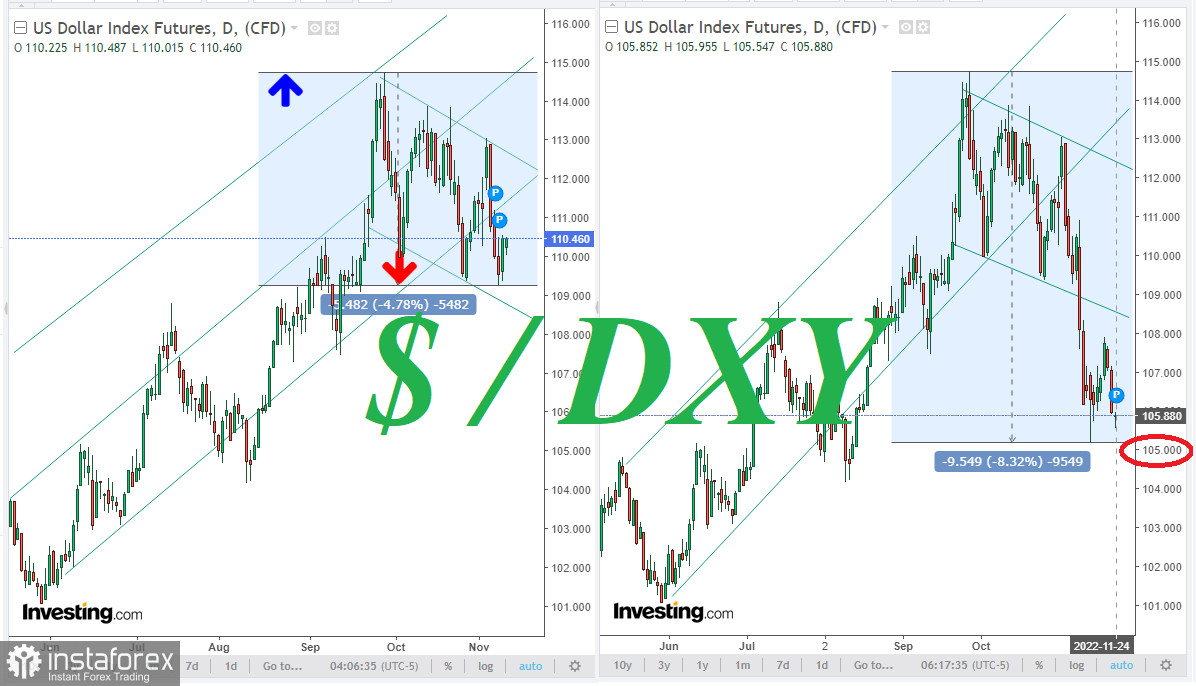The dollar remained under pressure on Thursday after the release of the US PMI business activity index on Wenesday, which showed a slowdown in November. According to the S&P Global Market Intelligence report, the US manufacturing activity index fell to 47.6 in November from 50.4 in October, which was also worse than the forecast of 50.
"Contributing to the decrease in the headline figure was a renewed fall in output and a sharper decline in new orders," S&P Global commented. They said "inflationary pressures should continue to cool in the months ahead, potentially markedly, but the economy meanwhile continues to head deeper into a likely recession."
"According to preliminary PMI survey data, the rate of decline in manufacturing and demand has increased, corresponding to a 1 percent year-over-year contraction in the economy," S&P Global also noted.
Business activity in the US services sector also continued to decline at an accelerating pace in early November, with the S&P Global Services PMI falling to 46.1 from 47.8 in October, worse than expected at 47.9. According to S&P Global Market Intelligence, new orders fell at a significant pace in November. The second consecutive monthly decline in new orders was the sharpest since May 2020.
Wednesday's negative investor sentiment was also exacerbated by the weekly report from the US Department of Labor: initial jobless claims came in at 240,000, worse than market expectations of 225,000 and 223,000 a week earlier.
This block of negative macro statistics affected market participants more than the positive report of the US Census Bureau, also published on Wednesday, which showed orders for durable goods in the US increased by 1% in October, against a September growth of 0.3% and market expectations of a 0.4% increase. "Excluding transport, new orders increased by 0.5%. Excluding the defense industry, new orders rose 0.8%," the US Census Bureau reported.
On Thursday, additional pressure on the dollar came from the release (at 19:00 GMT) of minutes from the Federal Reserve's November meeting, which showed that most of the US central bank's leadership supports the idea of slowing the pace of rate hikes in the near future. At the same time, inflation expectations in the US are declining.
Market participants now expect the Fed rate hike in December by 50 basis points. According to the CME Group, that probability is currently 76%.
Thus, the dollar is likely to remain under pressure on Thursday and in the coming days, especially given the Thanksgiving holiday period (today and tomorrow) in the US and the low activity of traders in that regard.
Today and tomorrow's economic calendar is also not rich with important macro statistics. In the meantime, market participants who follow the euro today will pay attention to the publication (12:30 GMT) of the minutes from the November ECB meeting.
This document contains an overview of the current policy of the ECB with planned changes in the financial and monetary areas. The publication of this document may cause a surge in volatility in trading in the euro and on the European stock market, and investors will carefully study the text of the protocols in order to catch additional signals regarding the prospects for the ECB's monetary policy.
As noted in our recent review, if the publication of US inflation data disappoints investors, it will provoke a new wave of dollar sell-offs and a drop in DXY towards 109.00. At that time, DXY futures were trading near 110.46, maintaining a negative momentum and moving in the lower part of the descending channel that formed last month (on the DXY chart).

A break of these levels could trigger a deeper drop in DXY, down to the key support levels of 107.40, 105.65, we assumed. Actually, this happened: the price broke through the lower border of the descending channel on the DXY chart at 109.00 and reached a local low of 105.15 in the next three days.
But this does not mean the dollar's decline will be more prolonged. At the very least, the 105.00 level should keep the DXY index from falling deeper, economists say, especially given growing concerns about new outbreaks of coronavirus, the ongoing geopolitical crisis in Europe and the risks of a recession in the largest economies of the world. In this situation, economists assume that the dollar should again win as a popular defensive asset.





















